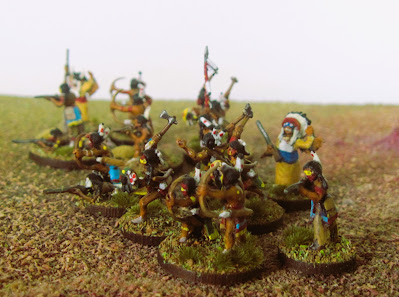The Elk Scrapers are my second Plains Indian Warrior Society. These ones are from Minifigs. Pleasingly, I got a big bag of them as an ebay bargain! A major project saving. They came on horse and on foot. These are very nice figures and easy to paint. Once again the band is 18 strong. As required by Yellow Ribbon I have them on foot too. You can see one has been designated as Leader.
The Warrior Societies competed for members and membership was taken seriously. Apart from scouting missions (Wolves) members always fought together. The tactical method was always the same. Locate and watch the foe, skirmish and then attack. Warfare was fluid in nature. There was one exception. If a village was attacked all warriors would stand and fight until all women children and elderly had been evacuated to safety.
Here is my rating for the Elk Scrapers Warrior Society. Medicine is high. Perhaps they are the survivors of the Powder River attack. Almost all Cheyenne survived that but they were utterly impoverished by the burning of their village. According to Scout Frank Grouard it had been a rich village. "Those Indians were well to do" he said. Naturally, they were furious. The Sioux re equipped them gratis.
|
Elk Scrapers |
Cheyenne Band |
Leader, Wooden Leg |
|
Movement
Foot |
Indian |
|
|
Movement
Mounted |
Crack |
|
|
Exhaustion
Foot |
11 |
|
|
Exhaustion
Mounted |
12 |
|
|
Field
Craft |
Crack |
|
|
Close
Combat |
Crack |
|
|
Marksmanship |
Good |
|
|
Weapon |
Well
Armed |
|
|
Medicine |
18 |
|
Normally, women did not fight. Yet, sometimes we read accounts of young women joining the warriors. Then, riding with the best of them, they killed. In each case that I have read this behaviour was occasioned by the death or injury of a young male relative.
Famously, a young Cheyenne woman fought at Little Big Horn. Here is another example. At the Rosebud a Crow warrior attempted to count coup on a Sioux. The Sioux shot him in the knee and de horsed him. Counting coup was always dangerous. The Crow had failed in the attempt and the Sioux came in for the kill. He was shot dead by a Crow woman who had joined the fight. Her brother had previously been killed by Sioux.
There is more. The fallen Sioux was scalped by the Crow woman. Subsequently, she distributed parts of the scalp to women of her village. Then, when the scalp dance was performed the women joined in each displaying their scrap of Sioux scalp.
The origin of Scalping is much disputed. Scalp Dances are much easier for us to locate. During a scalp dance every warrior displayed the scalps he had taken. He then sang and boasted of the how and when. His women folk then acted as a sort of Greek Chorus. They echoed his words, shouting his exploits. This was a high point in Plains Warrior culture.
To be an Indian was to compete for in tribe status. Status came from hunting and warrior skills. The more meat and hides provided, Coup counted, scalps taken the higher the status accrued.
The pressure on young men to gain status was immense. Older warriors already had it. Paint patterns of coup counted and men killed, scalps adorning war shields and lances all fore fronted their achievements. Scalp dances provided an additional reminder of who was who. Young men yearned to be counted in.
This brought tensions as America advanced. Red Cloud could afford to sit on his reservation. No one could challenge his warrior status. He had killed the foe, won his wars, brought fame to his name. A young man seeking similar status, by necessity, must go to war. There was no other way.
On a Reservation a young Indian normally could not go to war and thus could not accrue status. Progression to full manhood was then denied him. This was destructive of Indian Society. Generational conflict was uncontained. It found various outlets-none of them good. The Comanches who we have yet to consider suffered most. We may look at that later.
Some responded to Army calls for hireling warriors. Once engaged they could fulfil their cultural imperative to war. They could then return home having achieved status. Or, possibly. That they had fought and killed their own kin was a serious breach of tribal mores. For Reservation Crow or Shoshone no such problem existed. They went out against traditional enemies.
We have not entirely reached those fraught times. In front of us is Powder River, The Rosebud and Little Big Horn. We also need to say more about the Army, the Kit Foxes and potential scenarios.







Very colourful, damn fine work!
ReplyDeleteThanks Ray. One more Band to come.
ReplyDeleteA colourful looking unit
ReplyDeleteThanks Neil.
DeleteStunning band.
ReplyDeleteMy favourite so far Richard.
DeleteNot a period I will ever game, but love looking at the painted units and reading about them too:)!
ReplyDeleteYeah, a minority interest for sure Steve. A compelling one all the same. Not least because it is so well documented. And, Colourful!
ReplyDelete